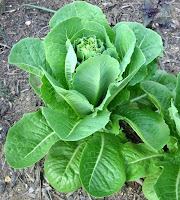 This year, more plants new to the backyard gardener have been planted than any past year. The first to make a blog post is the Cleome (Cleome hassleriana), also called spider flower or grandfather's whiskers. The lavender cleome from the Sparkler series was selected from the Park Seed catalog because of its lavender color and dwarf height. The front display garden is small, and does not need any freakishly tall plants hulking over everything. Also, subtle colors were needed in the summer to soften the cannas and sunflowers shouting for attention.
This year, more plants new to the backyard gardener have been planted than any past year. The first to make a blog post is the Cleome (Cleome hassleriana), also called spider flower or grandfather's whiskers. The lavender cleome from the Sparkler series was selected from the Park Seed catalog because of its lavender color and dwarf height. The front display garden is small, and does not need any freakishly tall plants hulking over everything. Also, subtle colors were needed in the summer to soften the cannas and sunflowers shouting for attention.The seeds were started and began growing in April - tiny, tiny seeds. After a painfully slow start, four plants eventually survived the poor germination and poor care and were hardened off and planted in the garden in June. They proceeded to do nothing after a month of constant nursing. Suddenly at the end of June, they began to grow, real fast.

Never having grown cleome before, this plant was full of surprises. If you haven't grown these, here are some facts you will not find in the garden catalogs:
- First, the 'Sparkler' plants are growing into bushes with several side stalks producing their own side stalks. They were apparently planted too close together - about 12-inches (30 cm) and are muscling in on the poor nearby zinnias and calendula.
- Second, dwarf with this plant means 4-feet (1.2 m) high. However, it's a good height for where they were planted.
- Third, where did the thorns come from? No catalog mentioned thorns.
- Fourth, the leaves stink.
- Fifth, the blossoms are somewhat light sensitive, and open fully at dusk until morning.
- Sixth, the lavender color seems pink, although lavender looks more true in these photos than the plants actually are
- Last, they look great, and will be back next year. Do these come back from seed true to their original?
For The Record: • Good, well-drained soil • Full sun • Small amount of organic fertilizer at transplant time • Unique flower form and number gets ooo's & aah's Garden Calendar: • Blooming: nicotiana, cosmos, coneflower, zinnia, nasturtium, loosestrife, cleome, snapdragon, hostas • Harvested: Broccoli • Progress: Tomatoes and peppers fruit reach full size |
















